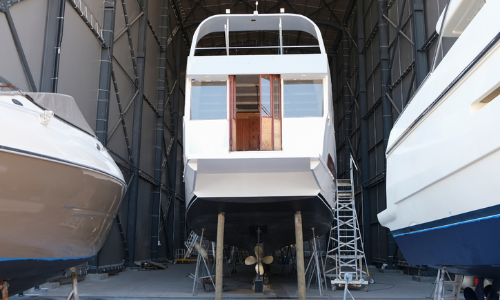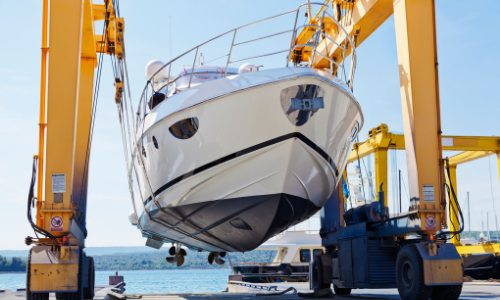
How to Clear Customs in the Bahamas
January 18, 2022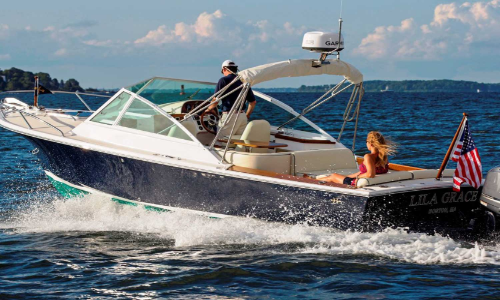
How To Buy a Boat
February 3, 2022What is Proper Boat Etiquette?
Knowing local boating laws is essential before heading out for a fun day of fishing, cruising, and watersports. However, it's also important to understand the unwritten rules of boating. Following these rules for proper boating etiquette can ensure that you and your guests stay safe, remain courteous to other boaters, and comply with boating regulations when visiting distant places.
Boat Flag Etiquette
One of the unspoken rules of boating is flying the appropriate flags. As a nod to mariners of old, displaying the correct flags lets you honor boating history and communicate effectively while on the water. There are four basic flag types to choose from:
Each flag has a specific purpose that signifies when their display is appropriate.
Flag Sizes
Each nautical flag's size should be proportional to the vessel itself.
In general, an ensign flag should be about one inch long for each foot of a yacht's overall length. Other flag sizes are based on the distance between the highest mast and the water.
Burgees, signals, and courtesy flags are roughly ½ inch long for each foot of the mast's length.
Flag Condition
In some cultures, flying a damaged or faded flag indicates disrespect, so it's important to keep your flags in good condition. Though you can remove flags to protect them when out alone on open water, be sure to raise them when entering or leaving port. Courtesy flags, in particular, should remain clearly visible, even at night.
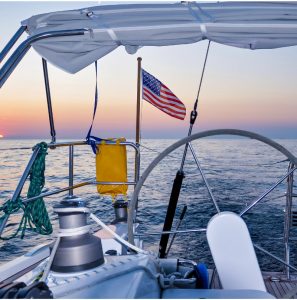
Ensign Flag
An ensign flag is the national flag of a vessel's origin point. In the United States, pleasure boaters can choose between the traditional 50-star flag or the yacht ensign, which features a fouled anchor over a circle of 13 stars. However, boaters should opt for the traditional flag rather than the yacht ensign when in foreign waters.
Most often, yacht owners fly their ensign flag from the stern, though you can also display the ensign from the leech of the most aftersail. When mounting a flagpole on the stern, locate it near the vessel's starboard side. Make sure the staff is sufficiently long and angled to keep it clear of any exhaust or rigging.
Flight times for ensign flags are reserved to the hours between 8:00 AM and sunset. Be sure to take it down if your craft is docked or unmanned before then. You should also remove the ensign during races to alert other boaters that you're engaged in that activity.
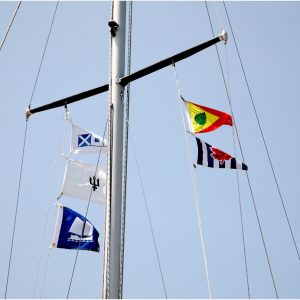
Burgee Flags
This small flag displays the logo of a particular sailing organization or yacht club. Traditionally, boaters fly the burgee as a symbol of honor on the starboard rigging. However, many people place it lower in the rig on a thin halyard near the lowest starboard spreader. While you typically fly this flag both day and night, you may need to remove it to show respect when sailing into a foreign port.

Private Signal Flags
A private signal flag is specific to a yacht's captain and is often custom-made. Each private signal flag corresponds to a particular person rather than the boat and should only be flown when the vessel is under that person's command. Fly these flags day or night from the head of the aftmost mast or from the starboard rigging on a sloop.
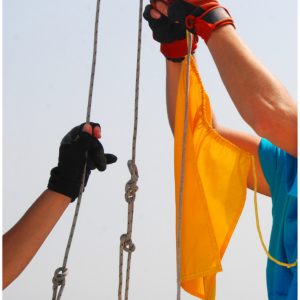
Courtesy Flags
When entering foreign waters or approaching national boundaries, it is proper boating etiquette to display that country's flag on the boat's starboard spreader. If your yacht has more than one mast, choose the starboard spreader of the forwardmost mast, even if it means temporarily displacing another flag for a time.
Before obtaining clearance from local authorities, all vessels should hoist a yellow "Q" flag to indicate a request for permission to enter. After receiving clearance, you can replace the "Q" flag with the appropriate national flag. If you are traveling to multiple locations, such as island nations, be sure to bring along a flag for each place you intend to visit.
Etiquette at the Marina
Around a marina slip, safety and cleanliness are the hallmarks of boating etiquette. Be considerate of others by keeping dock lines, cables and gear stowed neatly away when not in use. When fueling or loading up supplies, move as quickly as possible so as not to block another boater's access. Keep noise levels appropriate and closely supervise any children so that others can enjoy their experience.
Boating Etiquette on the Water
Practicing proper boating etiquette on the water means understanding and obeying the rules regarding boating right of way and passing. When two boats come head-on, each vessel should turn starboard and pass port to port. If a boat approaches you from the right, they are the "stand-on vessel" with the right of way, while you are the "give-way vessel" and must accommodate them.
Boating right of way rules can sometimes change depending on the type of vessel you have and the types of vessels you encounter while on the water. For example:
- Sailboats under sail have the right of way over powerboats. A sailboat that runs on an engine is considered a powerboat whether its sails are up or down.
- In an encounter between two sailboats under sail, the one on the starboard tack has the right of way over the vessel on the port tack. If both boats are on the same tack, the leeward vessel has the right of way.
- Human-powered vessels such as kayaks and canoes always have the right of way over other vessels, even sailboats.
- Vessels with limited maneuvering abilities due to draft, size, or other reasons have the right of way, while other boats must accommodate them.
All boaters should know and obey these guidelines for boat passing etiquette. However, avoiding collisions and maintaining safety is the main priority, regardless of which vessel technically has the right of way. If another boat is overtaking you, maintain course and speed if you can do so safely. Otherwise, slow down and allow the other vessel to pass.
Boat Docking Etiquette
When entering the marina or approaching a slip, slow your speed to six knots or less for safety. Though the goal is to get situated as quickly as possible, this will give you more time to react to other boaters and help minimize noise levels. If you're boating at a new location, watch a few other boaters before you approach to gauge the traffic flow.
When it's your turn, enlist a friend to help so the process goes as smoothly as possible. Move as quickly as possible to secure your boat and avoid causing damage to it or the dock. Once you've secured your vessel, rather than immediately unloading your extra fuel and equipment, move away from the ramp to give other boaters room.
Boat Etiquette for Guests
Like the captain and crew, guests must practice proper boating etiquette to ensure everyone stays safe and has a good time. If you receive a boating invitation, ask if there is anything the host would like for you to bring (food, drinks, sunscreen, extra towels, etc.). Or, offer to chip in on expenses like food, fuel, or boating fees.
On the day of the boating trip, be sure to arrive at the docks on time to ensure that everything remains on schedule. Volunteer to help out with the boat prep, loading, and launching processes however you can and perform whatever tasks the host gives you to the best of your ability. Before boarding, remove your shoes to avoid damaging or scuffing the vessel.
Since the captain is responsible for the safety of everyone aboard the boat, following their instructions is essential once you're out on the water. Ask your host if you have any questions, and avoid the following actions:
AVOID:
If the captain asks, assist with boat retrieval at the end of the trip. Help unload the vessel once you return to the staging area, remembering to clean up any messes and take all your personal items with you when you disembark. Lastly, be sure to thank the captain or host for inviting you onto their boat and showing you a good time.
Prioritize Safety and Maintain Courtesy
Again, safety and courtesy are the key tenets of proper boating etiquette. Follow all written regulations for your yachting or boating location, and use these tips on launching, passing, boating right of way, boat docking, and guest etiquette to ensure that your day on the water is fun and accident-free.


